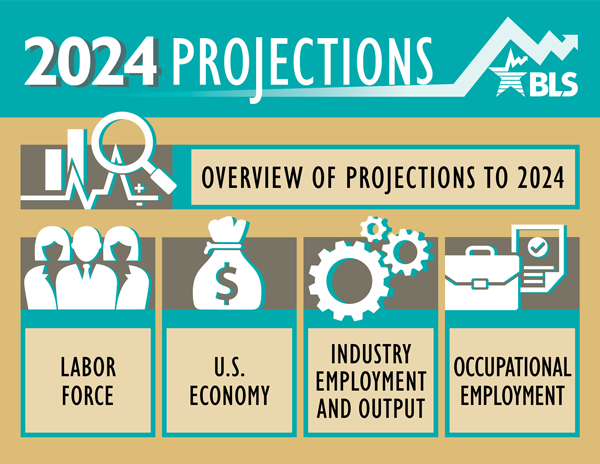An official website of the United States government
 United States Department of Labor
United States Department of Labor

Crossref 0
Macroeconomic Feedback Effects of Medicaid Expansion: Evidence from Michigan, Journal of Health Politics, Policy and Law, 2020.
Testing R&D-Based Endogenous Growth Models, SSRN Electronic Journal, 2017.
As a result of the aging population, the Bureau of Labor Statistics (BLS) projects a decline in the labor force participation rate over the coming decade. The aging population also will spur an increase in the demand for healthcare services, resulting in the healthcare industry and its related occupations accounting for a large share of new jobs projected through 2024.
The Monthly Labor Review features information about the Bureau of Labor Statistics (BLS) 2014–24 projections. Every 2 years, BLS publishes projections for the labor force, the macroeconomy, industry employment, and occupational employment. The projections data provide an overview of expected changes in the economy over a 10-year period. These projections are based on the assumption of a full-employment economy in 2024. BLS does not attempt to predict business cycle fluctuations that might occur during the projection period.
BLS projects that total employment will increase from 150.5 million to 160.3 million over the 2014–24 period. These projections reflect the aging of the population, with slower growth in the labor force and in the overall economy. The aging population also will lead to increased demand for healthcare services, which is projected to result in strong employment growth in the healthcare and social assistance sector, as well as in occupations related to healthcare. Highlights of the 2014–24 projections include the following:
Labor force supply is determined by the labor force participation rate and changes in the civilian noninstitutional population. Over the 2014–24 period, BLS expects that civilian noninstitutional population growth will slow to 0.8 percent annually. As the population ages, more workers will enter older age cohorts, which have lower participation rates. This will cause the projected overall participation rate to decline. This slower population growth, combined with the declining participation rate, will result in slower growth in the labor force through 2024.
Gross domestic product (GDP) is projected to grow at an average annual rate of 2.2 percent from 2014 to 2024, faster than the rate of 1.6 percent annually from 2004-14, but much slower than the 3.0-percent-and-higher annual growth rate experienced in the four prior decades. GDP growth is driven by growth in labor force supply and labor force productivity; the latter is expected to increase at an average annual rate of 1.8 percent over the projections period. This rate is consistent with long-term trends but faster than the rate that occurred following the last economic downturn.
Macroeconomic projections provide context for the detailed industry and occupation projections. Increased demand for healthcare services will result from the aging population and from expanded insurance coverage stemming from federal health insurance reform. Demand for healthcare services is expected to result in strong job growth in the healthcare and social assistance sector, which will account for over one-third of total projected job growth through 2024.
Demand for healthcare also will impact occupational employment growth, with healthcare practitioners and technical occupations (16.4 percent) and healthcare support occupations (23.0 percent) expected to grow much faster than the average rate of 6.5 percent for all occupations, adding 2.3 million jobs by 2024. Other occupational groups expected to grow much faster than average include personal care and service occupations (13.2 percent) and computer and math occupations (13.1 percent).
The construction sector and the occupations that support it are projected to add the majority of jobs in the goods-producing sector. Despite this growth, employment levels in this sector are not expected to reach those attained before the most recent recession. Although most sectors of the economy are expected to grow, employment in manufacturing, federal government, and agriculture are projected to decline. These sectors are expected to shed a combined 1.3 million jobs by 2024.
BLS projections provide the basis for the Occupational Outlook Handbook (OOH), the federal government’s premier career information resource. The 2016–17 OOH contains detailed career information in 329 occupational profiles, covering 83 percent of the jobs in the U.S. economy. Projections data are used by a variety of customers, including job seekers, students, career counselors, and policymakers, among others.
1 For more information about changing demographics in the labor force, see Mitra Toossi, “Labor force projections to 2024: the labor force is growing, but slowly,” Monthly Labor Review, December 2015.
2 For more information about projected changes in the macroeconomy, see Kathryn Byun and Bradley Nicholson, “The U.S. economy to 2024,” Monthly Labor Review, December 2015.
3 For industry employment and output projections, see Richard L. Henderson, “Industry employment and output projections to 2024,” Monthly Labor Review, December 2015.
4 For occupational employment projections, see Andrew Hogan and Brian Roberts, “Occupational employment projections to 2024,” Monthly Labor Review, December 2015.
Emily Richards, "Overview of projections to 2024," Monthly Labor Review, U.S. Bureau of Labor Statistics, December 2015, https://doi.org/10.21916/mlr.2015.50